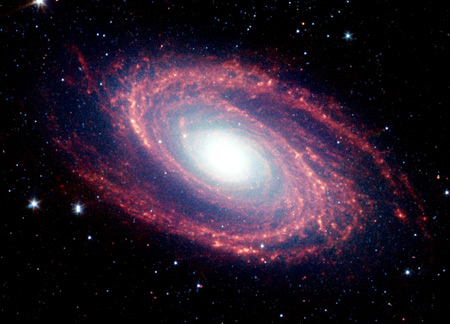
Astronomers think they've got a pretty good handle on how today's galaxies formed. About 13 billion years ago, enormous clouds of dust and gas produced by the big bang began coalescing around central cores of dark matter. Fairly quickly these clouds further condensed and differentiated into millions of stars, many of which were far larger than our sun. Then two more things happened: The large stars burned up their nuclear fuel very quickly and exploded into supernovae. And the primordial galaxies collided and merged to form bigger and bigger versions of themselves, in the process triggering more star formation and more supernovae.
The end result was that the biggest galaxies are now full of what astronomers call metals--the elements such as oxygen, carbon, and iron that are heavier than helium--all of which were forged in the incredible heat and pressures generated by supernovae. So when astronomers study large galaxies, such as our Milky Way, they expect to see an abundance of these hefty elements.
But not so with a group of 15 galaxies detected as part of a much larger survey called KISS--for KPNO International Spectroscopic Survey. Instead of exhibiting the usual characteristics of large and mature galaxies--as do the other 2500 KISS subjects--these galactic cousins showed spectra, or light characteristics, indicating they contain almost no metals. At the same time, their discoverers report this week in Astrophysical Journal Letters, the group members appear to be only 3 billion to 4 billion years old, or far younger than galaxies of that size should be.
It's a puzzle, says astronomer and lead author John Salzer of Indiana University, Bloomington. But "as time goes on, they might quickly evolve into galaxies that have properties that look more like the ones we see around us today," he says. And that possibility could be valuable, because if the 15 are late-forming galaxies, they're close enough "to give us a unique opportunity to study galaxy-formation processes," he explains.
The results are striking, "like finding 6-foot-tall people who are only 8 years old," says astronomer David Weinberg of Ohio State University in Columbus. But there might be another explanation, he says. It's possible that the galaxies are the products of recent mergers. If so, he explains, as the galaxies combined, a lot of hydrogen and helium would be mixed into their central regions, diluting the metals. "If this is what's going on," he says, "then the galaxies are not truly young, just recently rejuvenated."



Reader Comments
to our Newsletter